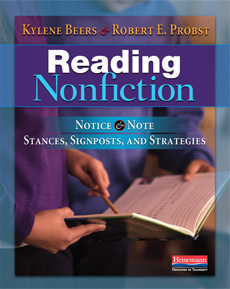
I'm excited that Alyson Beecher, at Kid Lit Frenzy, is continuing her Nonfiction Picture Book Challenge for the fifth year in a row!

Reading Nonfiction: Notice & Note Stances, Signposts, and Strategies by Kylene Beers & Robert E. Probst
In lieu of featuring nonfiction picture books this week, I thought I'd share a professional book I'm reading and an online book study in which I'm participating. I appreciate Beers' and Probst's senses of humor, self-deprecation (I appreciate their realness in reporting their interactions with students), and simple yet thorough way of presenting their material. Because we are all "encouraged" to be teaching more nonfiction, and therefore, our students are reading more nonfiction (I would assume), we need more strategies for helping our students with healthy skepticism (p. 146). Is the nonfiction they're reading actually true, or is the author intruding upon our world with his own agenda (pp. 39-40)? Beers and Probst encourage us to teach kids this distinction.
Because I teach gifted students, I agree with the authors' assertion that the "least skilled and most skilled readers tend to see the fewest signposts." They go on to say, "Our most skilled are often fast readers and, grasping the big meaning, rush right past the details that we want students to notice." So true! I look forward to using some of the strategies offered in this book this fall.
One of my big takeaways so far (I'm on page 148) is that the kind of critical thinking Beers and Probst encourage us to teach will stretch kids' thinking and help them challenge any assumptions/opinions they may already have. In this current cultural climate, I think this is huge. This is not to say their assumptions or opinions aren't okay or correct, it just makes kids read widely and deeply to either validate their thinking or possibly change it. The struggle to get kids to acknowledge anything that challenges them seems to be pervasive among adults as well. Not just "other" adults, but me! I have to think deeply about whether or not I allow myself to be challenged by different thinking before I can expect my students to do so. It's an incredibly sophisticated way of reading. How many adults do you know that only watch a certain news show or read a certain newspaper because it already reflects their thinking? This may be okay if those adults have already explored the various sides of an issue, but not if it is a knee-jerk reaction or a reflection of hearing someone else talk/write about it. If we can get kids to open their minds early in the game (and I don't mean "open" as non-decisive or passive, but as open to new/different thinking), maybe we can hope for a better future! I think it would be important to let kids know that we adults struggle with this, too. I hear Extreme or Absolute Language (signpost 2) coming from my students often, so if they're taught to recognize and analyze this kind of language, it may help them realize that it doesn't always reflect the truth.
One of my big takeaways so far (I'm on page 148) is that the kind of critical thinking Beers and Probst encourage us to teach will stretch kids' thinking and help them challenge any assumptions/opinions they may already have. In this current cultural climate, I think this is huge. This is not to say their assumptions or opinions aren't okay or correct, it just makes kids read widely and deeply to either validate their thinking or possibly change it. The struggle to get kids to acknowledge anything that challenges them seems to be pervasive among adults as well. Not just "other" adults, but me! I have to think deeply about whether or not I allow myself to be challenged by different thinking before I can expect my students to do so. It's an incredibly sophisticated way of reading. How many adults do you know that only watch a certain news show or read a certain newspaper because it already reflects their thinking? This may be okay if those adults have already explored the various sides of an issue, but not if it is a knee-jerk reaction or a reflection of hearing someone else talk/write about it. If we can get kids to open their minds early in the game (and I don't mean "open" as non-decisive or passive, but as open to new/different thinking), maybe we can hope for a better future! I think it would be important to let kids know that we adults struggle with this, too. I hear Extreme or Absolute Language (signpost 2) coming from my students often, so if they're taught to recognize and analyze this kind of language, it may help them realize that it doesn't always reflect the truth.
A teacher extraordinaire from a nearby district, Heidi Weber, is offering a free online book study for anyone who would like to work through this book this summer. It's not too late to jump in! We'd love to hear from more educators and their thinking on the big questions and signposts Beers and Probst teach us. If you're interested, click here.
For our educator night, we are making sure to feature more nonfiction selections. Fortunately there are lots of great ones to choose from this year!
ReplyDeleteI have this book and really need to get to it! We've dabbled with the signposts for fiction, but need to get more structured about using them consistently. Thanks for this quick view!
ReplyDelete